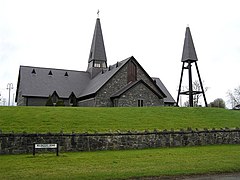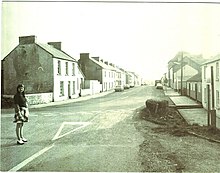
Clones is a small town in the west of County Monaghan in Ireland. The area is part of the Border Region in the Republic of Ireland, earmarked for economic development by the Irish Government due to its currently below-average economic situation. The town was badly hit economically by the Partition of Ireland in 1921 because of its location on the border with County Fermanagh in Northern Ireland. The creation of the Irish border deprived it of access to a large part of its economic hinterland for many years. The town had a population of 1,885 at the 2022 census. The town is in a civil parish of the same name.

Sir Phelim Roe O'Neill of Kinard was an Irish politician and soldier who started the Irish rebellion in Ulster on 23 October 1641. He joined the Irish Catholic Confederation in 1642 and fought in the Wars of the Three Kingdoms under his cousin, Owen Roe O'Neill, in the Confederate Ulster Army. After the Cromwellian conquest of Ireland O’Neill went into hiding but was captured, tried and executed in 1653.
The Battle of Newtownbutler took place near Enniskillen in County Fermanagh, Ireland, in 1689 and was part of the Williamite War in Ireland between the forces of William III and Mary II and those of King James II.
A list of the Lord Lieutenants of Fermanagh, located County Fermanagh of Northern Ireland, U.K.

Augher is a small village in south County Tyrone, Northern Ireland. It lies just 6 miles to the border with County Monaghan and is 16 miles south of Dungannon. It is situated in the historic barony of Clogher and the civil parish of Clogher. The 2001 Census recorded a population of 399. The town gives its name to the local Gaelic Football Club.

Kilskeery is a small village and civil parish in County Tyrone, Northern Ireland. It is between Ballinamallard and Trillick. In the 2001 census it had a population of 57 people. Kilskeery is within the Omagh District Council area.
Hugh McShane O'Neill was an early modern Irish nobleman and rebel associated with the McShanes of Glenconkeyne and Killetra. This group was also called the "Wild Clan Shanes of Killetragh" or the "McShane-O'Neills". His parentage is disputed however he is claimed by some as being either a grandson or great-grandson of Conn O'Neill, 1st Earl of Tyrone, and Gearoid Mór Fitzgerald, 8th Earl of Kildare, and of the primary line of the O'Neill of Tyrone clan.

Trillick St Macartan's is a Gaelic Athletic Association club based in the parish of Trillick in western County Tyrone, Northern Ireland. It competes at Senior level in Tyrone GAA competitions. The club plays Gaelic football, ladies' Gaelic football and camogie.
McCaul, also spelt MacCawell is an Irish surname, derived from the Gaelic Mac Cathmhaoil, meaning the "son of Cathmhaol", descendant of being implied. The name Cathmhaoil itself is derived from cath mhaol meaning "battle chief". The Mac Cathmhaoil were the leading family of Cenél Fearadhaigh, of the Uí Néill, and were based around Clogher in modern-day County Tyrone, Northern Ireland. They were one of the seven powerful septs that supported the O'Neills. Mac Cathmhaoil is now rare in Ulster as it has been Anglicised under various different forms such as, Campbell, McCawl, Caulfield, McCall, Alwell, Callwell, McCowell, Cowell, McCuill, Howell, MacHall, and McQuade.
Crom Castle is a country house on the shores of Upper Lough Erne in County Fermanagh, Northern Ireland, the seat of the Earls Erne. Standing within the 1,900-acre (7.7 km2) Crom Estate, and within a formal garden, the castle is built in stone. A central battlemented tower includes the main entrance, and there are also smaller towers to one side. It stands apart from the ruins of Old Crom Castle, of which two towers, some walls, and a ha-ha survive, and near them two ancient yew trees, believed to be at least 800 years old.
Alexander MacDonnell, 3rd Earl of AntrimPC (Ire) was a Catholic peer and military commander in Ireland. He fought together with his brother Randal on the losing side in the Irish Confederate Wars (1641–1653); and then, having succeeded his brother as the 3rd Earl of Antrim in 1683, fought in the Williamite War (1688–1691), on the losing side again. Twice he forfeited his lands and twice he regained them.
Sir Audley Mervyn of Trillick (1603?–1675) was a lawyer and politician in seventeenth-century Ireland. He was MP for County Tyrone and Speaker of the Irish House of Commons 1661–1666.
Henry MacShane O'Neill was an Irish flaith (nobleman) and a son of Shane O'Neill. He was the leader of the MacShanes in the late 16th century and early 17th century, and sought control of the O'Neill Clan, fighting with his brother Art against Hugh O'Neill.
Colonel Gordon O'Neill, was an officer in King James II's Irish army who fought at the Siege of Derry, the Battle of the Boyne, and the Battle of Aughrim for the Jacobites.
Sir Cormac MacBaron O'Neill (d.1613) was an Irish soldier and landowner of the Elizabethan and early Stuart eras. He was part of the O'Neill dynasty, one of the most prominent Gaelic families in Ireland.
Sir Turlough McHenry O'Neill is known for having been killed together with his father, Henry, fighting for the crown in O'Doherty's Rebellion and for being the father of Sir Phelim O'Neill, who started the Irish Rebellion of 1641.

The siege of Enniskillen took place at Enniskillen in Fermanagh, present day Northern Ireland, in 1594 and 1595, during the Nine Years' War. In February 1594, the English had captured Enniskillen Castle from the Irish after a waterborne assault and massacred the defenders after they surrendered. From May 1594, an Irish army under Hugh Maguire and Cormac MacBaron O'Neill besieged the English garrison in the castle, and in August they defeated an English relief force. A second relief force was allowed to resupply the garrison, but the castle remained cut off. Eventually, in May 1595, the English garrison surrendered to the Irish and were then massacred.

The siege of Carrickfergus took place in August 1689 when a force of Williamite troops under Marshal Schomberg landed and laid siege to the Jacobite garrison of Carrickfergus in Ireland. After a week the Jacobites surrendered, and were allowed to march out with the honours of war.
Colonel Rory Maguire was an Irish politician and soldier. He was a leading instigator of the Irish Rebellion of 1641 and subsequently participated in the Irish Confederate Wars as a senior Confederate commander.









